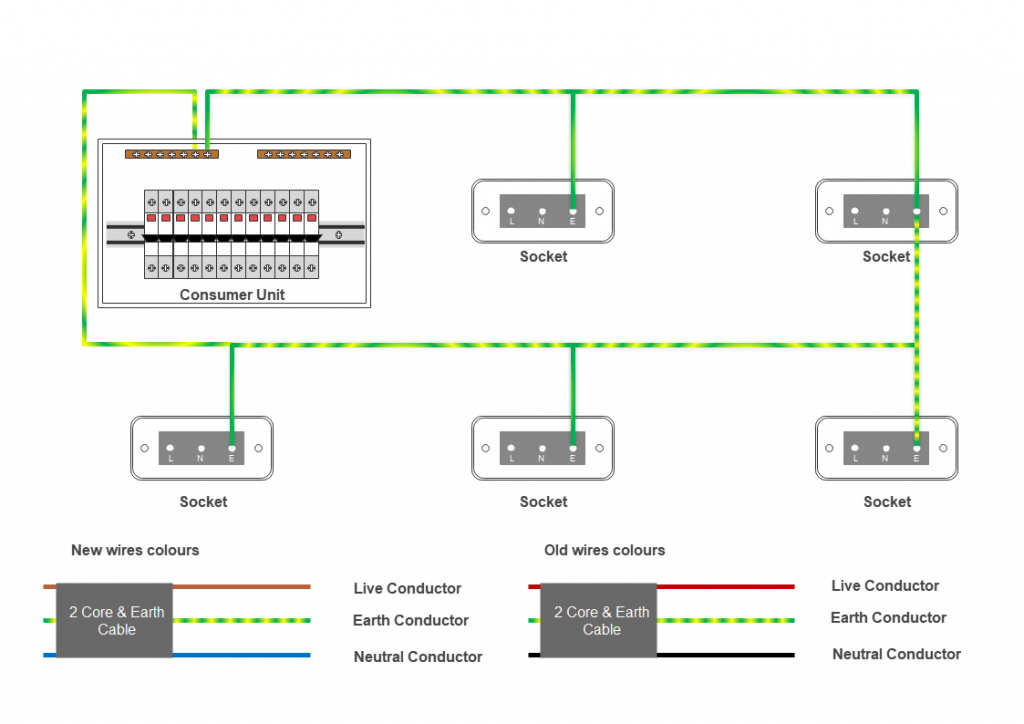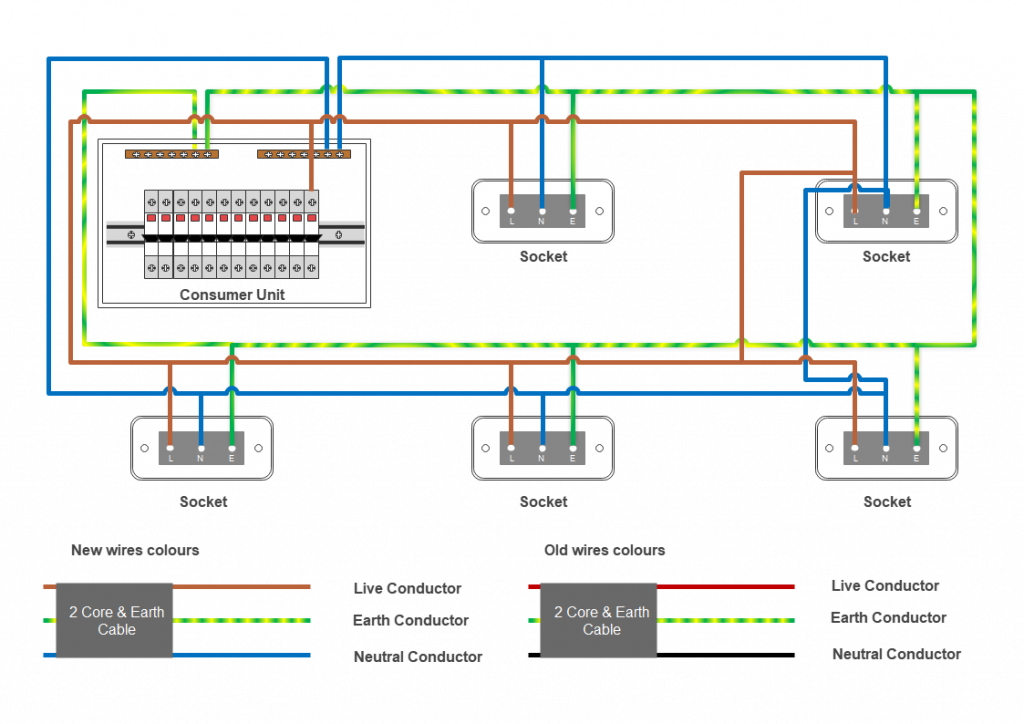Ring circuits for sockets are only installed in the UK. These were previously known as the Ring Main. In a ring circuit, a cable is installed in a ring, which means the cable leaves the consumer unit and returns to it from the last socket outlet to complete the continuous ring of the cables. This means current flows in both legs of the cable, and we have halved the current flow along each leg, even at maximum demand, which is 16 A. In practice, it’s never exactly equal, but it’s much lower than the maximum permitted in a single 2.5mm cable.

Table of Contents
When Ring Circuits (Ring Main) Designed?
Ring circuits were designed after the Second World War as part of a national rebuilding plan in the UK. The government’s think tank on rebuilding came up with a more efficient and cost-effective way to use less cabling for installing socket circuits with 32A circuit breakers or 30A for old rewireable fuses. It ultimately provided a cost-effective solution that saved on the consumption of copper during circuit installations.
Initially, an entire house would have one circuit for sockets as the ring main, but nowadays, they are installed separately for the ground floor, first floor, or kitchen socket due to the number of appliances that require more power, and so on.
What Is the Use of Ring Circuits (Ring Main)?
Ring circuits are used for socket outlets, and these can cover a longer floor area with a given amount of copper cable. Its cost effective and efficient way of house wiring.
What materials are required for a Ring Circuit (Ring Main)?
To create a ring circuit, you’ll need the following materials:
- 2.5mm Flat Twin & Earth cable or 2.5 Singe Core Brown, Blue, and Earth cables.
- 32A circuit breaker.
- Yellow/Green earth-sleeving.
- The required number of sockets and back boxes.
- Cable entry grommets, screws, and raw plugs.
How to Wire the Ring Circuit (Ring Main)?
Wiring a ring circuit is straightforward. A ring circuit cable leg leaves the consumer unit and loops between all the socket outlets then returns to the consumer unit. This method of installation is the same whether you are using single-core 2.5mm cables Live as Brown(L), Neutral as Blue(N), and Earth as Yellow/Green(E) or Flat Twin & Earth cable, which is essentially the same Brown(L), Blue(N), and 1.5mm bare copper for Earth(E) in one cable.
For flat twin & earth cable, run one leg from the consumer unit to the first socket, then loop between all the required socket outlets. Finally, from the last socket, run the same cable leg back to the consumer to complete the ring circuit. In the case of single-core cable, you’ll do the same but ensure you run three wires Brown(L), Blue(N), and Yellow/Green(E).
How to Terminate the Ring Circuit (Ring Main)?
Terminating a ring circuit is simple and straightforward. In a ring circuit, you’ll have two Live (L), two Neutral(N), and two Earth(E) wires in the consumer unit, as well as in each socket. Here are the steps:
Step 1:
For Flat Twin & Earth cable, the bare conductor is the earth wire(E), and you must put sleeving that is color-coded yellow and green. Terminate the earth wires into the earth bar at the consumer unit and do the same at each socket where the terminal is marked (E) or color-coded yellow/green.

Step 2:
The two neutral(N) wires should be terminated at the neutral bar in the consumer unit, and do the same at each socket where the terminal is marked (N) or color-coded blue.
If you are using a 32A RCBO as the circuit breaker in the consumer unit, then the neutral (N) wire must be terminated at the marked neutral terminal on the RCBO. However, the RCBO has a neutral wire that should be terminated to the neutral bar in the consumer unit to complete the circuit.

Step 3:
Finally, the last two brown(L) wires must be terminated at the 32A circuit breaker (MCB) outgoing terminal or marked Live terminal in case RCBO is used, which is at the top terminal of the breaker. Do the same termination at the socket, usually marked as (L) and color-coded brown.

What are the problems with the Ring circuit (Ring Main)?
The ring circuit is a reliable technology, but it requires periodic inspection and testing to ensure it is operating safely. Because current travels in both directions in a ring, with two legs coming out of the consumer unit, if any of the ring wires come loose or have a break over time, it can lead to issues.
For example, if a circuit for sockets is wired as a radial circuit for devices like a TV and a fridge, a break in the wire would cause the circuit to stop working from the point where the break occurs. However, with both of these appliances on a ring circuit, there will always be an alternative path for the current to travel. Nevertheless, a broken ring main circuit could potentially cause short-circuiting due to overheating, heat stress, or a live cable touching any conductive part, posing a safety hazard. Hence the period inspection could prevent the danger of electric shock.
How many sockets can be installed in a Ring Circuit (Ring Main)?
In terms of how many sockets you can have there is no set number, you can put 10 or 15 whatever but generally, it comes to load in use and common sense. As we know it was designed in 1940 the requirement of load in use is different than today, it recommended potential load calculation on ring circuits by calculating demand and diversity.
Conclusion
Ring circuits, previously known as ring mains, offer a cost-effective and efficient way to wire socket circuits, saving on cable lengths, circuit breakers, and installation effort compared to radial circuits. However, they require periodic testing to ensure safety. It is common practice to install ring circuits in house wiring with RCD circuit breakers, which monitor the circuit and prevent fatal electric shocks if you come into contact with live current, such as a bare wire.
Related Posts:
Resources:

